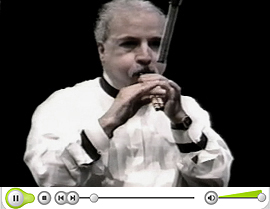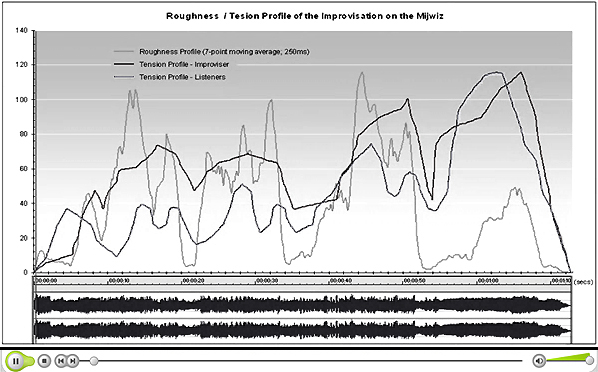|
ORGANIZING AND RECOGNIZING MUSICAL TENSION/RELEASE PATTERNS MAY BE
CULTURE DEPENDENT
Performing and listening to an improvisation
on the Middle Eastern mijwiz
Pantelis N. Vassilakis, Ph.D.
DePaul University School of Music
804 W. Belden Ave. Chicago, IL 60614-3250
http://www.acousticslab.com -
pantelis@acousticslab.com
Popular version of paper 3aMU5
Presented Wednesday morning, May 18, 2005
149th ASA Meeting, Vancouver, BC, Canada
|
|
|
|
Overview: Musical tension/release and auditory roughness contrasts
Our ability to attach meaningful
and emotional qualities to instrumental pieces of music relies, to a
large extent, on our recognition of potential musical tension/release patterns within a piece. Such patterns can be set up using a
variety of sonic and sonic-organization tools, whose significance
and potential to communicate meaning and emotion
appears to largely depend on previous small-scale (personal) and
large-scale (cultural) learning.
Within the Western musical tradition, studies have shown
that musical tension/release judgments are linked to contrasts in
terms of: i) tonal center (e.g. key), ii) sensory dissonance, iii) dynamics, iv)
pitch, v) rhythm, vi) orchestration, vii) performance techniques, etc.,
with sensory dissonance correlating with the presence of auditory
roughness. The term auditory roughness describes a rattling sound associated with certain types of signals
such as those of narrow harmonic intervals. The potency of the
suggested contrasts depends on familiarity with musical norms that
are, largely, culturally defined.
As the above list suggests, auditory roughness
contrasts within a piece constitute just one of the
sonic tools (cues) that help set-up (determine) musical
tension/release patterns. In addition, the strong link, within
Western tradition, between roughness and annoyance, and the
assumption that rough sounds should be avoided, limit the range of
roughness variations explored, further reducing the contribution of
auditory roughness contrasts to the organization and recognition of musical tension
and release.
As we will see, the situation may be quite different when it comes to
non-Western musical traditions.
|
|
|
|
A Matter of Audience: Auditory roughness contrasts in
non-Western musical traditions
Performance practices outside
the Western art musical tradition explore a much wider roughness
range, indicating that the sensation of roughness can be of much more
importance in the production of musical sound and the
communication of expressive intent. In many such cases, the
increased importance of auditory roughness as a sonic and
sonic-organization device is accompanied by a decrease in the
importance of other relevant devices.
For example, the Middle
Eastern mijwiz (two paired single-reed pipes) is constructed and performed in
ways that limit the possibilities for extensive exploration of
dynamic, pitch, tonal, and timbral (other than roughness) contrasts.
More specifically, the mijwiz:
a) requires performers to maintain high pressure air-flow in order
to sustain a steady tone, limiting its dynamic range;
b) is often performed using the circular
breathing technique, limiting the possibilities for interplay
between sound and silence;
c) has narrow
melodic range (~a fifth) and limited harmonic menu (no melodic line
crossing), resulting in limited possibilities for melodic/harmonic
contrasts;
d) has two reeds that are activated just by
air pressure (with no manipulation possible from the lips or tongue,
as would be the case for a clarinet-like instrument), limiting the
possibilities for timbral contrasts associated with vibrato or other forms
of spectral manipulation.
|
For its expressive power, the mijwiz, like
most double-pipes throughout history, relies mainly on the
exploration of narrow harmonic intervals. Such explorations
correspond to
manipulation and exploration of roughness degrees, making
musical pieces performed on the mijwiz good candidates for the
examination of the relationship between roughness profiles and
patterns of musical tension.
Click on the image to the right
to see a performance of the mijwiz piece used in the present study.
[Real
format - Click here to download a
free Real Player - IE 6.0 / Netscape 7.0 or later required] |
 |
|
|
|
A Perceptual Study: Auditory
roughness profiles and tension/release patterns in an improvisation
on the Middle Eastern mijwiz
The present study examined a
recording of a stylized improvisation on the mijwiz, performed by
Prof. A. J. Racy, a Lebanese-born musician and scholar at the University of
California, Los Angeles, Department of Ethnomusicology (click on the
image above to see the
performance).
The roughness profile of the recorded piece was
estimated using a custom application that automates frequency
analysis and roughness calculation of complex signals, at
user-specified time intervals.
The application is
available online (http://www.acousticslab.com/roughness),
including detailed descriptions of the relevant analysis and calculation
methods. Briefly, the frequency analysis portion uses an improved STFT
algorithm based on the Reassigned Bandwidth-Enhanced Additive Model
by Dr. K. Fitz, while the roughness calculation portion is based on
a roughness estimation model introduced and tested in a previous
study by the author.
The roughness profile was compared to
tension/release patterns indicated by the improviser and expert
mijwiz player as well as by Western-trained musicians, in a
perceptual experiment designed using Prof. R. A. Kendall's Music
Experiment Development System (MEDS).
The results suggest that auditory roughness is a good predictor of
the tension/release pattern indicated by the improviser. The
patterns obtained by the subjects show a different trend. Auditory
roughness appears to be just one of the cues guiding musical tension
judgments, often overridden by tonal and temporal cues, as well as
by expectations of tension/resolution raised by such cues.
Click on
the image below to see a video clip of the results.
|
|
|
|
Discussion: Same musical piece
different musical understandings
|

|
The results may be interpreted
in terms of different listening strategies employed by the two
different types of listeners, strategies that are related to
musical expectations outlined by the
different underlying musical traditions.
From the improviser's point of
view, roughness contrasts created
through frequent moves between narrow and unison harmonic intervals
constitute musical expressive cues that are widely accepted and employed
within the Near Eastern musical tradition to communicate changes in musical tension. Composers
and performers incorporate
these contrasts when setting up tension/release patterns and
listeners look out for them, even if implicitly, when they
organize perceptually and attach meaning to musical pieces.
From the point of view of
listeners raised within the Western musical tradition, auditory
roughness contrasts play a limited role when it comes to identifying
musical tension/release patterns, while tonal and temporal contrasts
provide more significant musical cues and set up stronger
tension/resolution expectations. As a result, when Western
raised/trained listeners are confronted with a musical piece such as
the one used in the present study, they continue to employ their
familiar strategies to parse the incoming sound, reaching an
interpretation that differs from the composers /
performers expressive intent.
The observed differences between the tension/release patterns
obtained, correspond to differences in the way relevant (to each
listener type) musical
cues are laid out in time within the mijwiz piece. For
example, points in the piece corresponding to high (low) roughness
values but low (high) tonal or temporal 'load', coincide with high
(low) tension judgments by the improviser but low (high) tension
judgments by the Western-trained listeners. This supports the suggestion that musical
tension and release are
culture-specific concepts, guided by the equally culture-specific
musical cues used to organize and recognize them.
|
|
|
|
Acknowledgements
Study supported by the Department of
Instructional Technology Development and the School of Music, DePaul
University. Special thanks to Profs. R. A. Kendall and A. J. Racy,
Ethnomusicology Department, University of California, Los Angeles,
for their expertise.
|
|